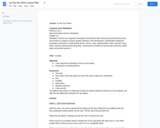
Objectives:
*Learn about the importance of the sun for plants
*Introduction to photosynthesis
- Subject:
- Living Systems and Processes
- Science
- Material Type:
- Activity/Lab
- Lesson Plan
- Provider:
- Healthy Planet USA
- Date Added:
- 06/29/2022

Objectives:
*Learn about the importance of the sun for plants
*Introduction to photosynthesis

Students become authors as they use technology to create an ebook to share with their classmates. Students chose the life cycle of a flowering plant, frog, or butterfly. They review with hands-on resources and peer collaboration. They then use their ipad with the app “Book Creator” to create a book using real life pictures!

Paul Andersen describes how free energy is used by organisms to grow, maintain order, and reproduce. A brief discussion of the first and second law of thermodynamics is also included. Worksheets and a transcript accompany this resource.
Transcript added from YouTube subtitles. You can use this to write your own worksheet or quiz.
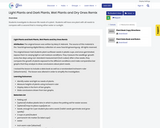
Students investigate to discover life needs of a plant. Students will have one plant with all needs to compare with a second that is missing either water or sunlight.

This science instructional plan (SIP) supports the Science Standards of Learning.
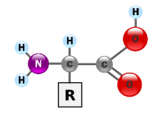
Carbon and other elements play a key role in determining the structure and function of macromolecules needed to sustain life processes. Life processes include growth and repair, reproduction, gas exchange, metabolism, and response. Cells make a variety of macromolecules needed for life processes from a relatively small set of monomers. These macromolecules include carbohydrates, proteins, nucleic acids, and lipids. This module was developed by Kristin Scheible as part of a Virginia Commonwealth University STEM initiative sponsored by the Virginia Department of Education.
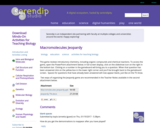
Students enjoy this Jeopardy game review of introductory chemistry, including organic compounds and chemical reactions.

Biology students often struggle to understand how it can be that the same two parents will produce genetically different offspring. This lab exercise is a very visual way to demonstrate the "making of a monster" one gene at a time. The resources include a full sheet of vocabulary and instructions, plus a data table to record the crosses. For advanced students, you can take the activity further with a sheet of follow up questions.
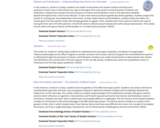
Students use model chromosomes and answer analysis and discussion questions to learn about meiosis and fertilization. As they model meiosis and fertilization, students follow the alleles of a human gene from the parents' body cells through gametes to zygotes; thus, students learn how a person inherits one copy of each gene from each of his/her parents. To learn how meiosis contributes to genetic variation, students analyze the results of crossing over and independent assortment. Students also compare and contrast meiosis and mitosis, and they learn how a mistake in meiosis can result in Down syndrome or death of an embryo. This activity helps students meet the Next Generation Science Standards.
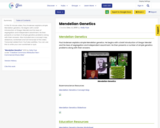
In this 16 minute video, Paul Andersen explains simple Mendelian genetics. He begins with a brief introduction of Gregor Mendel and his laws of segregation and independent assortment. He then presents a number of simple genetics problems along with their answers.
Also included are a concept map, slideshow, worksheet and full transcript of the video.
Transcript added from YouTube subtitles. You can use this to write your own worksheet or quiz.
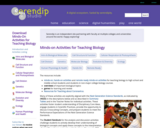
The Student Handouts for these minds-on activities challenge students to actively develop their understanding of biological concepts and apply these concepts to the interpretation of scientific evidence and real-world situations. The Teacher Notes provide learning goals, instructional suggestions, relevant scientific background, and suggestions for preparatory and follow-up activities. Many of these activities are explicitly aligned with the Next Generation Science Standards.
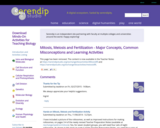
These teacher notes summarize important concepts for students to understand concerning mitosis and meiosis, including the principle that understanding meiosis and fertilization provides the basis for understanding the fundamentals of inheritance. The proposed sequence of learning activities will help students understand and learn these major concepts and progress beyond common misconceptions. This overview provides links to suggested activities which include a hands-on simulation of mitosis meiosis and fertilization, a card sort of activity, a vocabulary review game and discussion questions.
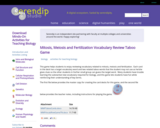
This game helps students to enjoy reviewing vocabulary related to mitosis, meiosis and fertilization. Each card in the deck has a target vocabulary word and two related taboo words that the student may not use when giving clues so the other students in his or her small group can guess the target word. Many students have trouble learning the substantial new vocabulary required for biology, and this game lets students have fun while reinforcing their understanding of key terms.
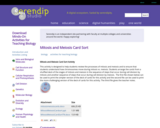
This minds-on activity is designed to help students review the processes of mitosis and meiosis and to ensure that students understand how chromosomes move during mitosis vs. meiosis. Students arrange the cards from a shuffled deck of the stages of mitosis and meiosis in the sequence of steps that occur during cell division by mitosis and another sequence of steps that occur during cell division by meiosis.
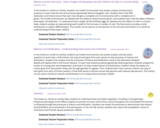
In this hands-on, minds-on activity students use model chromosomes and answer analysis and discussion questions to learn how the cell cycle produces genetically identical daughter cells. Students learn how DNA replication and mitosis ensure that each new cell gets a complete set of chromosomes with a complete set of genes. Students learn why each cell needs a complete set of genes and how genes influence phenotypic characteristics. Finally, students analyze exponential growth to understand how a single cell develops into the trillions of cells in a human body. This activity helps students meet the Next Generation Science Standards.

This lesson plan is about creating digital models in teaching phases of mitosis.
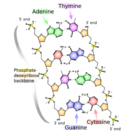
Students will participate in a 5E lesson. To ENGAGE, students will connect their understanding of the characteristics of life to the fundamental molecule of life: DNA. To EXPLORE, students will extract DNA from fruit in a hands on (or video of a) lab, and then, students will act as Watson and Crick and use clues to discover the structure of DNA. In the EXPLAIN section, students will use slides to fill out guided notes on the structure of DNA and RNA. To ELABORATE on their understanding of DNA, students can participate in the CRISPR-Cas9 interactive and the Regulation of the Lactase Gene click and learn. Formative evaluations of students's ability to model DNA include (1) using an online interactive, (2) using their bodies as a class, and (3) using a cut and paste model. Finally, the summative EVALUATE is a DNA Model FlipGrid in which students use various materials to construct and explain the structure of DNA.
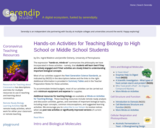
Students design experiments to determine how substrate and environmental conditions influence growth of common molds. Students carry out their experiments, analyze and interpret their evidence, and prepare a report.
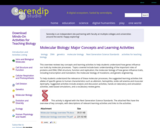
This overview reviews key concepts and learning activities to help students understand how genes influence our traits by molecular processes. Topics covered include basic understanding of the important roles of proteins and DNA; DNA structure, function and replication; the molecular biology of how genes influence traits, including transcription and translation; and the molecular biology of mutations. To help students understand the relevance of these molecular processes, the suggested learning activities link alleles of specific genes to human characteristics such as albinism, sickle cell anemia and muscular dystrophy. This overview provides links to suggested activities which include hands-on laboratory and simulation activities, web-based simulations, discussion activities and a vocabulary review game.
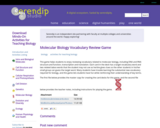
This game helps students to enjoy reviewing vocabulary related to molecular biology, including DNA and RNA structure and function, transcription and translation. Each card in the deck has a target vocabulary word and two related taboo words that the student may not use when giving clues so the other students in his or her small group can guess the target word. Many students have trouble learning the substantial new vocabulary required for biology, and this game lets students have fun while reinforcing their understanding of key terms.